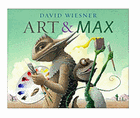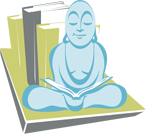
In the best of friendships, each friend plays a part in influencing and awakening the other. In the case of Art and Max, the two lizard heroes of David Wiesner's penetrating exploration of the creative process, we literally get to watch how they inspire changes in each other through the evolution of their artwork. Arthur--or Art, as Max likes to call him--begins as the accomplished artist, while Max is the novice. But in this masterful picture book, the student teaches the teacher.
Wiesner sets the stage with the cover, as he often does. Arthur (pictured on the left) towers over Max (at right). Arthur, slit-eyed and perfectly composed, balances his palette with paints carefully arranged. Max may be small of stature, but he holds his yellow paint high, like a torch, his wide eyes fixed upon it. Each protagonist grasps a virgin paintbrush, and they stand back to back, as if about to begin a duel.
Max's feet do not touch the ground as he approaches Arthur, arms outstretched, on the title page spread. Arthur, absorbed in his work, paints a rose-tinted lizard that's concentrating on its pose. An orange lizard leans forward to watch Arthur paint. Only a small yellow lizard sees Max coming. Max kicks up dust in his enthusiasm and also sends Arthur's paintbrush flying ("Careful, Max!"). "Hey, Art, that's great!" Max says. Arthur proclaims his lines of dialogue in the stately serif font (Century Schoolbook) you'd find in Dick and Jane books or other classroom texts. Max's lines, on the other hand, appear in a san serif font (Magma Halo Italic) that emits the same kind of energy he does, urgent and excited. Their verbal exchanges unfold with no need for attribution.
 First Arthur's easel, then Max's dominate the spreads. The drama plays out in the desert, where the sandy floor takes up little more than an inch-width band on the pages, and the vast sky forms Wiesner's canvas. As he did with Flotsam, the author-artist creates a world within a world. Max, with a blank stare and brushes in hand, stands with his back to a bare canvas as if paralyzed by what to place upon it. A blank page, a blank canvas: every child, writer or painter knows that feeling of intimidation. How to begin? "Well... you could paint me," Arthur says. "You? Really?" And Max does. He places his paintbrush directly on Arthur's scaly skin and, in a series of panel illustrations, leaves a trail of thick blue, yellow and red paint. The primary colors. The sky turns from mint green to gold to red.
First Arthur's easel, then Max's dominate the spreads. The drama plays out in the desert, where the sandy floor takes up little more than an inch-width band on the pages, and the vast sky forms Wiesner's canvas. As he did with Flotsam, the author-artist creates a world within a world. Max, with a blank stare and brushes in hand, stands with his back to a bare canvas as if paralyzed by what to place upon it. A blank page, a blank canvas: every child, writer or painter knows that feeling of intimidation. How to begin? "Well... you could paint me," Arthur says. "You? Really?" And Max does. He places his paintbrush directly on Arthur's scaly skin and, in a series of panel illustrations, leaves a trail of thick blue, yellow and red paint. The primary colors. The sky turns from mint green to gold to red.
 "MAAAAAX!" Arthur shouts as the paint on his belly cracks. Max's eyes are trained on this crackling of the paint. The paint explodes in a torrent on a wordless spread, as the lizard onlookers go flying. The thick paint falls away to reveal a layer of pastels below. Max brings out the fan next. The chalky consistency of the pastels blow off in a rainbow breeze. A drink of water washes away Art's watercolor layer. Art is now an India-ink drawing. But through all of these incarnations, Art's essence remains. As Max tries to hold onto Art ("It's Arthur!" the giant lizard insists), the line drawing unravels like a misshapen wire coat hanger. With only the pale blue sky as his canvas, Max begins to reconstruct Art. Alone. But his expression looks very different from when he had his back to that blank canvas. He knows what he wants to accomplish. His first attempt is clumsy, but Max doesn't give up ("More detail, I think," says Max). As Max adds in the forehead, the nubby row of protrusions on the brow line, the delicate fingers, we begin to recognize Art. "Acceptable, I suppose"--high praise from the master lizard. But Max is not finished. He returns with an Acme vacuum cleaner, sucking up every last paint speck he can find. "Now hold still," Max tells Arthur, as he blows back the speckles in a stream of paint. With a turn of a page, Art appears in a pixilated splendor worthy of Georges Seurat. Max has indeed "painted" Arthur.
"MAAAAAX!" Arthur shouts as the paint on his belly cracks. Max's eyes are trained on this crackling of the paint. The paint explodes in a torrent on a wordless spread, as the lizard onlookers go flying. The thick paint falls away to reveal a layer of pastels below. Max brings out the fan next. The chalky consistency of the pastels blow off in a rainbow breeze. A drink of water washes away Art's watercolor layer. Art is now an India-ink drawing. But through all of these incarnations, Art's essence remains. As Max tries to hold onto Art ("It's Arthur!" the giant lizard insists), the line drawing unravels like a misshapen wire coat hanger. With only the pale blue sky as his canvas, Max begins to reconstruct Art. Alone. But his expression looks very different from when he had his back to that blank canvas. He knows what he wants to accomplish. His first attempt is clumsy, but Max doesn't give up ("More detail, I think," says Max). As Max adds in the forehead, the nubby row of protrusions on the brow line, the delicate fingers, we begin to recognize Art. "Acceptable, I suppose"--high praise from the master lizard. But Max is not finished. He returns with an Acme vacuum cleaner, sucking up every last paint speck he can find. "Now hold still," Max tells Arthur, as he blows back the speckles in a stream of paint. With a turn of a page, Art appears in a pixilated splendor worthy of Georges Seurat. Max has indeed "painted" Arthur.
In the final scene, when they both pick up their paintbrushes, Art and Max are changed as characters and, consequently, as artists. Now it is Max who primly holds a palette, as he paints the yellow and orange lizards in a Van Gogh fashion, while Art lifts his paint cans high and applies sweeping arcs of paint in a dancelike motion reminiscent of Jackson Pollock. Not on a canvas, but on a cactus. Max has gained some of Art's discipline; Art has acquired some of Max's spontaneity. They play, experiment, stretch. One of the hallmarks of Wiesner's work is that the more we look, the more we see. At its core, this is a story of friendship, and the way Art and Max each contribute to the other. It's also a not-so-thinly disguised metaphor for the fact that our experience of art changes us, and we as witnesses also bring something to the art. The book is the visual equivalent of Ars Poetica.
Best of all, Art and Max's example demonstrates that we never stop growing. There is no one right way to do anything. We can only find our way through experimentation and play. And we don't have to do it alone. This may well be Wiesner's most playful, joyful book to date. A masterpiece.

